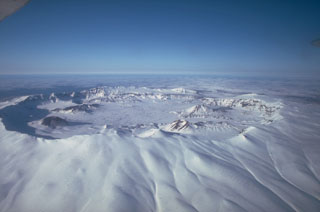Report on Okmok (United States) — March 1997
Bulletin of the Global Volcanism Network, vol. 22, no. 3 (March 1997)
Managing Editor: Richard Wunderman.
Okmok (United States) Emission of steam, ash, and lava continues
Please cite this report as:
Global Volcanism Program, 1997. Report on Okmok (United States) (Wunderman, R., ed.). Bulletin of the Global Volcanism Network, 22:3. Smithsonian Institution. https://doi.org/10.5479/si.GVP.BGVN199703-311290
Okmok
United States
53.43°N, 168.13°W; summit elev. 1073 m
All times are local (unless otherwise noted)
Reports on 27 March, and 4, 11, 18, and 25 April, confirmed that the eruption which began on 13 February was continuing at relatively low levels. Satellite images examined by AVO indicated the presence of hot lava flows in the caldera, and occasional thin, low-level plumes drifting downwind from the volcano. NOAA/NESDIS also reported that on 4 April an aircraft pilot saw lava flows and [observed] an ash column at ~3,500 m, drifting slowly SE. On 12 April another ash plume was reported by a pilot at 2.4 km; this same plume was detected in visible and infrared satellite imagery.
Okmok volcano is not monitored seismically and is not assigned a color code. Based on past eruptive history, lava flows and low--level ash emission could continue for weeks to months. Eruptive activity could intensify at any time.
Geological Summary. The basaltic Okmok shield volcano forms the NE end of Umnak Island in the Aleutian Islands. The summit of the low, 35-km-wide volcano is cut by two overlapping 10-km-wide calderas formed during eruptions about 12,000 and 2,050 years ago when dacitic pyroclastic flows reached the coast. More than 60 tephra layers from Okmok have been found overlying the 12,000-year-old caldera-forming tephra layer. Numerous cones and lava domes are present on the flanks down to the coast, including the SE-flank Mount Tulik, which is almost 200 m higher than the caldera rim. Some of the post-caldera cones show evidence of wave-cut lake terraces; more recent cones were formed after the caldera lake, once 150 m deep, disappeared. Eruptions have been reported since 1805 from cinder cones within the caldera, where there are also hot springs and fumaroles.
Information Contacts: Alaska Volcano Observatory (AVO); NOAA/NESDIS Satellite Analysis Branch (SAB).

